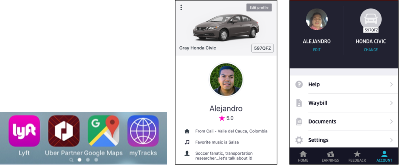The impact of ride hailing on parking (and vice versa)
Abstract
Researching emerging transportation services is critical to forecasting mode choice and providing appropriate infrastructure. One such infrastructure is parking, as parking demand may shift with the availability of ride-hailing services. This study uses ethnographic methods - complemented with passenger surveys collected when driving for Uber and Lyft in the Denver, Colorado, region - to gather quantitative and qualitative data on ride-hailing and analyze the impacts of ride-hailing on parking, including changes in parking demand and parking as a reason to deter driving. The study also examines relationships between parking time and cost. This includes building a classification tree-based model to predict the replaced driving trips as a function of car ownership, destination land type, parking stress, and demographics. The results suggest that: i) ride-hailing is replacing driving trips and could reduce parking demand, particularly at land uses such as airports, event venues, restaurants, and bars; ii) parking stress is a key reason respondents chose not to drive; and iii) respondents are generally willing to pay more for reduced parking time and distance. Conversely, parking supply, time, and cost can all influence travel behavior and ride-hailing use. This work provides insight into potential benefits and disadvantages of ride-hailing as related tomore »
- Authors:
-
- National Renewable Energy Lab. (NREL), Golden, CO (United States)
- Univ. of Colorado, Denver, CO (United States)
- Publication Date:
- Research Org.:
- National Renewable Energy Lab. (NREL), Golden, CO (United States)
- Sponsoring Org.:
- U.S. Department of Transportation (DOT)
- OSTI Identifier:
- 1512671
- Report Number(s):
- NREL/JA-5400-73889
Journal ID: ISSN 1938-7849
- Grant/Contract Number:
- AC36-08GO28308
- Resource Type:
- Accepted Manuscript
- Journal Name:
- Journal of Transport and Land Use
- Additional Journal Information:
- Journal Volume: 12; Journal Issue: 1; Journal ID: ISSN 1938-7849
- Country of Publication:
- United States
- Language:
- English
- Subject:
- 29 ENERGY PLANNING, POLICY, AND ECONOMY; ride-hailing; ridesourcing; TNC; Uber; Lyft; parking; curb space; TDM
Citation Formats
Henao, Alejandro, and Marshall, Wesley E. The impact of ride hailing on parking (and vice versa). United States: N. p., 2019.
Web. doi:10.5198/jtlu.2019.1392.
Henao, Alejandro, & Marshall, Wesley E. The impact of ride hailing on parking (and vice versa). United States. https://doi.org/10.5198/jtlu.2019.1392
Henao, Alejandro, and Marshall, Wesley E. Mon .
"The impact of ride hailing on parking (and vice versa)". United States. https://doi.org/10.5198/jtlu.2019.1392. https://www.osti.gov/servlets/purl/1512671.
@article{osti_1512671,
title = {The impact of ride hailing on parking (and vice versa)},
author = {Henao, Alejandro and Marshall, Wesley E.},
abstractNote = {Researching emerging transportation services is critical to forecasting mode choice and providing appropriate infrastructure. One such infrastructure is parking, as parking demand may shift with the availability of ride-hailing services. This study uses ethnographic methods - complemented with passenger surveys collected when driving for Uber and Lyft in the Denver, Colorado, region - to gather quantitative and qualitative data on ride-hailing and analyze the impacts of ride-hailing on parking, including changes in parking demand and parking as a reason to deter driving. The study also examines relationships between parking time and cost. This includes building a classification tree-based model to predict the replaced driving trips as a function of car ownership, destination land type, parking stress, and demographics. The results suggest that: i) ride-hailing is replacing driving trips and could reduce parking demand, particularly at land uses such as airports, event venues, restaurants, and bars; ii) parking stress is a key reason respondents chose not to drive; and iii) respondents are generally willing to pay more for reduced parking time and distance. Conversely, parking supply, time, and cost can all influence travel behavior and ride-hailing use. This work provides insight into potential benefits and disadvantages of ride-hailing as related to parking.},
doi = {10.5198/jtlu.2019.1392},
journal = {Journal of Transport and Land Use},
number = 1,
volume = 12,
place = {United States},
year = {Mon Feb 18 00:00:00 EST 2019},
month = {Mon Feb 18 00:00:00 EST 2019}
}
Figures / Tables:
 Figure 1: Lyft and Uber driver profiles and smartphone apps
Figure 1: Lyft and Uber driver profiles and smartphone apps
Works referencing / citing this record:
Ride-hailing, travel behaviour and sustainable mobility: an international review
journal, November 2019
- Tirachini, Alejandro
- Transportation, Vol. 47, Issue 4
Figures / Tables found in this record:

 Search WorldCat to find libraries that may hold this journal
Search WorldCat to find libraries that may hold this journal